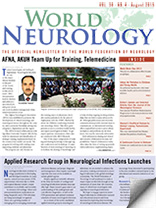Environmental Neurology, Neurodegeneration, Air Pollution and Young Urbanites
By Lillian Calderón-Garcidueñas, MA, MD, PhD, and Jacques Reis, MD
Ambient air pollution is a key disease risk factor producing detrimental health effects on millions of people, particularly children and young adults, across the global community. The neurological effects associated with sustained exposures to concentrations of outdoor air pollutants above the current international air quality standards are an important issue for people living in megacities and small towns around the world and those involved in high-risk occupational settings. Outdoor air pollutants are complex mixtures of particulate matter (PM), gases, and organic and inorganic compounds emitted directly into the air from combustion of fossil fuels, such as gas, oil, coal and fires.
New York; Toronto; Salt Lake City; Fairbanks, Alaska; Provo, Utah; the Los Angeles-South Coast Air Basin; Paris; La Oroya, Peru; Santiago, Chile; New Delhi; Beijing; Karachi, Pakistan; Krakow, Poland; Venice, Italy; Frankfurt, Germany; Brussels; and Mexico City residents share their main sources of pollution: transport, industry and heating. Particulate matter fine particles larger than 100 nm and smaller than 2.5 μm (PM2.5) and ultrafine PM <100 nm are target sizes for brain effects, and their main sources are road traffic and industrial emissions.
The detrimental impact of air pollution upon the brain in development is critical, as are the long-term potential neurodegenerative consequences upon children and young adults. Air pollution also is a risk factor in multiple sclerosis. We will discuss these topics in our T 20 Thursday, Nov. 5, 2015, Environmental Neurology XII Congress of World Neurology in Santiago, Chile.
Oxidative stress and brisk inflammatory responses are important features present in animal models and in humans exposed to polluted environments with diverse particulate matter chemistry as well as high concentrations of criteria pollutants.
Neuroinflammation is a key component of air pollution exposures. Megacity children exhibit significant frontal lobe imbalance in genes essential for inflammation, innate and adaptive immune responses, oxidative stress, cell proliferation and apoptosis. The up-regulation of potent inflammatory mediators involves supra and infratentorial regions and cranial nerves, including olfactory bulb, frontal cortex, substantia nigrae and the vagus.
Breakdown of the nasal, olfactory, gastrointestinal, alveolar-capillary and the brain-blood barriers has been extensively documented. There is evidence the GI tract barrier also is compromised in the air pollution setting, and recent research links inflammatory bowel diseases, changes in gut microbiome and abdominal pain with air pollution. The GI breakdown likely impacts neuronal enteric populations, and PM could reach the vagus and the brainstem. We suggested that damage to epithelial and endothelial barriers associated with air pollution exposures is a robust trigger of tight junction and neural antibodies.
Early dysregulated neuroinflammation, brain microvascular damage, production of potent vasoconstrictors, and perturbations in the integrity of the neurovascular unit are seen in children and young adults exposed to urban air pollution. The accumulation of misfolded hyperphosphorylated tau, alpha-synuclein and beta-amyloid coincides with the anatomical distribution observed in the early stages of both Alzheimer’s and Parkinson’s diseases.
Major depressive episodes are linked to neuroinflammation and systemic markers of inflammation. Epidemiological, cognitive, structural, and functional neuroimaging and mechanistic studies into the association between air pollution exposures and the development of neuroinflammation and neurodegeneration in children are of pressing importance for public health.
Air pollution has become a key issue in public health and in environmental sciences.
What can we do? Knowledge of the issue is imperative. Improvement of air quality is a must, and neuroprevention should be at the core of our efforts as health care providers.
